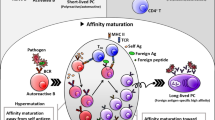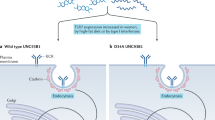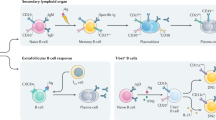Abstract
When B cells react aggressively against self, the potential for pathology is extreme. It is therefore not surprising that B-cell depletion is seen as an attractive therapy in autoimmune diseases. However, B cells can also be essential for restraining unwanted autoaggressive T-cell responses. Recent advances have pointed to interleukin-10 (IL-10) production as a key component in B-cell-mediated immune regulation. In this Opinion article, we develop a hypothesis that triggering of Toll-like receptors controls the propensity of B cells for IL-10 production and immune suppression. According to this model, B cells can translate exposure to certain microbial infections into protection from chronic inflammatory diseases.
This is a preview of subscription content, access via your institution
Access options
Subscribe to this journal
Receive 12 print issues and online access
$209.00 per year
only $17.42 per issue
Buy this article
- Purchase on Springer Link
- Instant access to full article PDF
Prices may be subject to local taxes which are calculated during checkout


Similar content being viewed by others
References
Wolf, S. D., Dittel, B. N., Hardardottir, F. & Janeway, C. A. Jr. Experimental autoimmune encephalomyelitis induction in genetically B cell-deficient mice. J. Exp. Med. 184, 2271–2278 (1996).
Fillatreau, S., Sweenie, C. H., McGeachy, M. J., Gray, D. & Anderton, S. M. B cells regulate autoimmunity by provision of IL-10. Nature Immunol. 3, 944–950 (2002).
Mizoguchi, A., Mizoguchi, E., Takedatsu, H., Blumberg, R. S. & Bhan, A. K. Chronic intestinal inflammatory condition generates IL-10-producing regulatory B cell subset characterized by CD1d upregulation. Immunity 16, 219–230 (2002).
Mauri, C., Gray, D., Mushtaq, N. & Londei, M. Prevention of arthritis by interleukin 10-producing B cells. J. Exp. Med. 197, 489–501 (2003).
Duddy, M. E., Alter, A. & Bar-Or, A. Distinct profiles of human B cell effector cytokines: a role in immune regulation? J. Immunol. 172, 3422–3427 (2004).
Duddy, M. et al. Distinct effector cytokine profiles of memory and naive human B cell subsets and implication in multiple sclerosis. J. Immunol. 178, 6092–6099 (2007).
MacLennan, I. C. Germinal centers. Annu. Rev. Immunol. 12, 117–139 (1994).
Vos, Q., Lees, A., Wu, Z. Q., Snapper, C. M. & Mond, J. J. B-cell activation by T-cell-independent type 2 antigens as an integral part of the humoral immune response to pathogenic microorganisms. Immunol. Rev. 176, 154–170 (2000).
Ito, T. et al. Plasmacytoid dendritic cells prime IL-10-producing T regulatory cells by inducible costimulator ligand. J. Exp. Med. 204, 105–115 (2007).
Mellor, A. L. et al. Cutting edge: CpG oligonucleotides induce splenic CD19+ dendritic cells to acquire potent indoleamine 2,3-dioxygenase-dependent T cell regulatory functions via IFN type 1 signaling. J. Immunol. 175, 5601–5605 (2005).
Wingender, G. et al. Systemic application of CpG-rich DNA suppresses adaptive T cell immunity via induction of IDO. Eur. J. Immunol. 36, 12–20 (2006).
Wu, H. J. et al. Inflammatory arthritis can be reined in by CpG-induced DC–NK cell cross talk. J. Exp. Med. 204, 1911–1922 (2007).
Matsushita, T. et al. Inhibitory role of CD19 in the progression of experimental autoimmune encephalomyelitis by regulating cytokine response. Am. J. Pathol. 168, 812–821 (2006).
Al-Alwan, M. M., Okkenhaug, K., Vanhaesebroeck, B., Hayflick, J. S. & Marshall, A. J. Requirement for phosphoinositide 3-kinase p110δ signaling in B cell antigen receptor-mediated antigen presentation. J. Immunol. 178, 2328–2335 (2007).
Okkenhaug, K. et al. Impaired B and T cell antigen receptor signaling in p110δ PI 3-kinase mutant mice. Science 297, 1031–1034 (2002).
Lehuen, A. et al. Overexpression of natural killer T cells protects Vα14– Jα281 transgenic nonobese diabetic mice against diabetes. J. Exp. Med. 188, 1831–1839 (1998).
Miyamoto, K., Miyake, S. & Yamamura, T. A synthetic glycolipid prevents autoimmune encephalomyelitis by inducing TH2 bias of natural killer T cells. Nature 413, 531–534 (2001).
Croxford, J. L., Miyake, S., Huang, Y. Y., Shimamura, M. & Yamamura, T. Invariant Vα19i T cells regulate autoimmune inflammation. Nature Immunol. 7, 987–994 (2006).
Wykes, M., Poudrier, J., Lindstedt, R. & Gray, D. Regulation of cytoplasmic, surface and soluble forms of CD40 ligand in mouse B cells. Eur. J. Immunol. 28, 548–559 (1998).
Desai-Mehta, A., Lu, L., Ramsey-Goldman, R. & Datta, S. K. Hyperexpression of CD40 ligand by B and T cells in human lupus and its role in pathogenic autoantibody production. J. Clin. Invest. 97, 2063–2073 (1996).
Amel Kashipaz, M. R. et al. Assessment of Be1 and Be2 cells in systemic lupus erythematosus indicates elevated interleukin-10 producing CD5+ B cells. Lupus 12, 356–363 (2003).
Díaz-Alderete, A., Crispin, J. C., Vargas-Rojas, M. I. & Alcocer-Varela, J. IL-10 production in B cells is confined to CD154+ cells in patients with systemic lupus erythematosus. J. Autoimmun. 23, 379–383 (2004).
Chong, W. P. et al. Association of interleukin-10 promoter polymorphisms with systemic lupus erythematosus. Genes Immun. 5, 484–492 (2004).
Moore, K. W., de Waal Malefyt, R., Coffman, R. L. & O'Garra, A. Interleukin-10 and the interleukin-10 receptor. Annu. Rev. Immunol. 19, 683–765 (2001).
Llorente, L. et al. Clinical and biologic effects of anti-interleukin-10 monoclonal antibody administration in systemic lupus erythematosus. Arthritis Rheum. 43, 1790–1800 (2000).
Ishida, H. et al. Continuous administration of anti-interleukin 10 antibodies delays onset of autoimmunity in NZB/W F1 mice. J. Exp. Med. 179, 305–310 (1994).
Higuchi, T. et al. Cutting Edge: Ectopic expression of CD40 ligand on B cells induces lupus-like autoimmune disease. J. Immunol. 168, 9–12 (2002).
Yin, Z. et al. IL-10 regulates murine lupus. J. Immunol. 169, 2148–2155 (2002).
Lampropoulou, V. et al. TLR-activated B cells suppress T cell-mediated autoimmunity. J. Immunol. 180, 4763–4773 (2008).
Barr, T. A., Brown, S., Ryan, G., Zhao, J. & Gray, D. TLR-mediated stimulation of APC: distinct cytokine responses of B cells and dendritic cells. Eur. J. Immunol. 37, 3040–3053 (2007).
Tian, J. et al. Lipopolysaccharide-activated B cells down-regulate Th1 immunity and prevent autoimmune diabetes in nonobese diabetic mice. J. Immunol. 167, 1081–1089 (2001).
Rudolph, U. et al. Ulcerative colitis and adenocarcinoma of the colon in Gαi2-deficient mice. Nature Genet. 10, 143–150 (1995).
Dalwadi, H. et al. B cell developmental requirement for the Gα i2 gene. J. Immunol. 170, 1707–1715 (2003).
Harris, D. P., Goodrich, S., Gerth, A. J., Peng, S. L. & Lund, F. E. Regulation of IFN-γ production by B effector 1 cells: essential roles for T-bet and the IFN-γ receptor. J. Immunol. 174, 6781–6790 (2005).
Harris, D. P. et al. Reciprocal regulation of polarized cytokine production by effector B and T cells. Nature Immunol. 1, 475–482 (2000).
Gray, M., Miles, K., Salter, D., Gray, D. & Savill, J. Apoptotic cells protect mice from autoimmune inflammation by the induction of regulatory B cells. Proc. Natl Acad. Sci. USA 104, 14080–14085 (2007).
Matsumura, Y., Byrne, S. N., Nghiem, D. X., Miyahara, Y. & Ullrich, S. E. A role for inflammatory mediators in the induction of immunoregulatory B cells. J. Immunol. 177, 4810–4817 (2006).
O'Garra, A. et al. Production of cytokines by mouse B cells: B lymphomas and normal B cells produce interleukin 10. Int. Immunol. 2, 821–832 (1990).
Wei, B. et al. Mesenteric B cells centrally inhibit CD4+ T cell colitis through interaction with regulatory T cell subsets. Proc. Natl Acad. Sci. USA 102, 2010–2015 (2005).
Whitmore, A. C., Haughton, G. & Arnold, L. W. Phenotype of B cells responding to the thymus-independent type-2 antigen polyvinyl pyrrolidinone. Int. Immunol. 8, 533–542 (1996).
Amano, M. et al. CD1 expression defines subsets of follicular and marginal zone B cells in the spleen: β2-microglobulin-dependent and independent forms. J. Immunol. 161, 1710–1717 (1998).
Loder, F. et al. B cell development in the spleen takes place in discrete steps and is determined by the quality of B cell receptor-derived signals. J. Exp. Med. 190, 75–89 (1999).
Evans, J. G. et al. Novel suppressive function of transitional 2 B cells in experimental arthritis. J. Immunol. 178, 7868–7878 (2007).
Moulin, V. et al. B lymphocytes regulate dendritic cell (DC) function in vivo: increased interleukin 12 production by DCs from B cell-deficient mice results in T helper cell type 1 deviation. J. Exp. Med. 192, 475–482 (2000).
Day, M. J., Tse, A. G., Puklavec, M., Simmonds, S. J. & Mason, D. W. Targeting autoantigen to B cells prevents the induction of a cell-mediated autoimmune disease in rats. J. Exp. Med. 175, 655–659 (1992).
Saoudi, A., Simmonds, S., Huitinga, I. & Mason, D. Prevention of experimental allergic encephalomyelitis in rats by targeting autoantigen to B cells: evidence that the protective mechanism depends on changes in the cytokine response and migratory properties of the autoantigen-specific T cells. J. Exp. Med. 182, 335–344 (1995).
Mizoguchi, A., Mizoguchi, E. & Bhan, A. K. The critical role of interleukin 4 but not interferon γ in the pathogenesis of colitis in T-cell receptor α mutant mice. Gastroenterology 116, 320–326 (1999).
Hoffmann, K. F., Cheever, A. W. & Wynn, T. A. IL-10 and the dangers of immune polarization: excessive type 1 and type 2 cytokine responses induce distinct forms of lethal immunopathology in murine schistosomiasis. J. Immunol. 164, 6406–6416 (2000).
Byrne, S. N. & Halliday, G. M. B cells activated in lymph nodes in response to ultraviolet irradiation or by interleukin-10 inhibit dendritic cell induction of immunity. J. Invest. Dermatol. 124, 570–578 (2005).
Segal, B. M., Dwyer, B. K. & Shevach, E. M. An interleukin (IL)-10/IL-12 immunoregulatory circuit controls susceptibility to autoimmune disease. J. Exp. Med. 187, 537–546 (1998).
Tuohy, V. K. et al. Modulation of the IL-10/IL-12 cytokine circuit by interferon-β inhibits the development of epitope spreading and disease progression in murine autoimmune encephalomyelitis. J. Neuroimmunol. 111, 55–63 (2000).
Sun, C. M., Deriaud, E., Leclerc, C. & Lo-Man, R. Upon TLR9 signaling, CD5+ B cells control the IL-12-dependent Th1-priming capacity of neonatal DCs. Immunity 22, 467–477 (2005).
Gerth, A. J., Lin, L., Neurath, M. F., Glimcher, L. H. & Peng, S. L. An innate cell-mediated, murine ulcerative colitis-like syndrome in the absence of nuclear factor of activated T cells. Gastroenterology 126, 1115–1121 (2004).
McGeachy, M. J., Stephens, L. A. & Anderton, S. M. Natural recovery and protection from autoimmune encephalomyelitis: contribution of CD4+CD25+ regulatory cells within the central nervous system. J. Immunol. 175, 3025–3032 (2005).
O'Connor, R. A., Malpass, K. H. & Anderton, S. M. The inflamed central nervous system drives the activation and rapid proliferation of Foxp3+ regulatory T cells. J. Immunol. 179, 958–966 (2007).
Mann, M. K., Maresz, K., Shriver, L. P., Tan, Y. & Dittel, B. N. B cell regulation of CD4+CD25+ T regulatory cells and IL-10 via B7 is essential for recovery from experimental autoimmune encephalomyelitis. J. Immunol. 178, 3447–3456 (2007).
Swallow, M. M., Wallin, J. J. & Sha, W. C. B7h, a novel costimulatory homolog of B7.1 and B7.2, is induced by TNFα. Immunity 11, 423–432 (1999).
Dong, C. et al. ICOS co-stimulatory receptor is essential for T-cell activation and function. Nature 409, 97–101 (2001).
Rottman, J. B. et al. The costimulatory molecule ICOS plays an important role in the immunopathogenesis of EAE. Nature Immunol. 2, 605–611 (2001).
Herman, A. E., Freeman, G. J., Mathis, D. & Benoist, C. CD4+CD25+ T regulatory cells dependent on ICOS promote regulation of effector cells in the prediabetic lesion. J. Exp. Med. 199, 1479–1489 (2004).
Ashour, H. M. & Niederkorn, J. Y. Peripheral tolerance via the anterior chamber of the eye: role of B cells in MHC class I and II antigen presentation. J. Immunol. 176, 5950–5957 (2006).
Kosiewicz, M. M. & Streilein, J. W. Intraocular injection of class II-restricted peptide induces an unexpected population of CD8 regulatory cells. J. Immunol. 157, 1905–1912 (1996).
Prinz, M. et al. Innate immunity mediated by TLR9 modulates pathogenicity in an animal model of multiple sclerosis. J. Clin. Invest. 116, 456–464 (2006).
Sartor, R. B. Therapeutic manipulation of the enteric microflora in inflammatory bowel diseases: antibiotics, probiotics, and prebiotics. Gastroenterology 126, 1620–1633 (2004).
Krieg, A. M. CpG motifs in bacterial DNA and their immune effects. Annu. Rev. Immunol. 20, 709–760 (2002).
Gursel, M., Verthelyi, D., Gursel, I., Ishii, K. J. & Klinman, D. M. Differential and competitive activation of human immune cells by distinct classes of CpG oligodeoxynucleotide. J. Leukoc. Biol. 71, 813–820 (2002).
Verthelyi, D. & Zeuner, R. A. Differential signaling by CpG DNA in DCs and B cells: not just TLR9. Trends Immunol. 24, 519–522 (2003).
Bach, J. F. The effect of infections on susceptibility to autoimmune and allergic diseases. N. Engl. J. Med. 347, 911–920 (2002).
Leibowitz, U. et al. Epidemiological study of multiple sclerosis in Israel. II. Multiple sclerosis and level of sanitation. J. Neurol. Neurosurg. Psychiatry 29, 60–68 (1966).
Correale, J. & Farez, M. Association between parasite infection and immune responses in multiple sclerosis. Ann. Neurol. 61, 97–108 (2007).
Velupillai, P. & Harn, D. A. Oligosaccharide-specific induction of interleukin 10 production by B220+ cells from schistosome-infected mice: a mechanism for regulation of CD4+ T-cell subsets. Proc. Natl Acad. Sci. USA 91, 18–22 (1994).
Mangan, N. E. et al. Helminth infection protects mice from anaphylaxis via IL-10-producing B cells. J. Immunol. 173, 6346–6356 (2004).
Danchenko, N., Satia, J. A. & Anthony, M. S. Epidemiology of systemic lupus erythematosus: a comparison of worldwide disease burden. Lupus 15, 308–318 (2006).
Martin, F. & Chan, A. C. B cell immunobiology in disease: evolving concepts from the clinic. Annu. Rev. Immunol. 24, 467–496 (2006).
Pitashny, M. & Shoenfeld, Y. B cell depletion in autoimmune rheumatic diseases. Autoimmun. Rev. 4, 436–441 (2005).
Hauser, S. L. et al. B-cell depletion with rituximab in relapsing-remitting multiple sclerosis. N. Engl. J. Med. 358, 676–688 (2008).
Ferraro, A. J., Drayson, M. T., Savage, C. O. & MacLennan, I. C. Levels of autoantibodies, unlike antibodies to all extrinsic antigen groups, fall following B cell depletion with Rituximab. Eur. J. Immunol. 38, 292–298 (2008).
Hu, C. Y. et al. Treatment with CD20-specific antibody prevents and reverses autoimmune diabetes in mice. J. Clin. Invest. 117, 3857–3867 (2007).
Thomas, P. G. et al. Maturation of dendritic cell 2 phenotype by a helminth glycan uses a Toll-like receptor 4-dependent mechanism. J. Immunol. 171, 5837–5841 (2003).
Palanivel, V. et al. B-cell outgrowth and ligand-specific production of IL-10 correlate with Th2 dominance in certain parasitic diseases. Exp. Parasitol. 84, 168–177 (1996).
Velupillai, P., Garcea, R. L. & Benjamin, T. L. Polyoma virus-like particles elicit polarized cytokine responses in APCs from tumor-susceptible and -resistant mice. J. Immunol. 176, 1148–1153 (2006).
Jude, B. A. et al. Subversion of the innate immune system by a retrovirus. Nature Immunol. 4, 573–578 (2003).
Acknowledgements
Work in the authors' laboratories is supported by the Deutsche Forschungsgemeinschaft (SFB-650), the Association pour la Recherche sur la Sclérose En Plaques (ARSEP), and the Hertie Stiftung (S.F.); the Wellcome Trust (D.G.); and the Medical Research Council, the Wellcome Trust and the UK Multiple Sclerosis Society (S.M.A.). S.M.A. is an MRC Senior Research Fellow and holds a Research Councils UK Fellowship in Translational Medicine.
Author information
Authors and Affiliations
Corresponding author
Related links
Glossary
- Anterior-chamber-associated immune deviation
-
(ACAID). Systemic antigen-specific tolerance that develops after inoculation of antigen into the immune-privileged site of the anterior chamber of the eye.
- Collagen-induced arthritis
-
(CIA). An experimental model of rheumatoid arthritis. Arthritis is induced by immunization of susceptible animals with type II collagen.
- Epitope spreading
-
A term originally applied to responses to autoantigens that tend to become more diverse as the response persists.
- Experimental autoimmune encephalomyelitis
-
(EAE). An animal model of multiple sclerosis. EAE can be induced in several mammalian species by immunization with myelin-derived antigens together with adjuvant. The immunized animals develop a paralytic disease with inflammation and demyelination in the brain and spinal cord that has several pathological features in common with multiple sclerosis in humans.
- Inflammatory bowel disease
-
(IBD). A chronic condition of the intestine that is characterized by severe inflammation and mucosal destruction. The commonest forms in humans are ulcerative colitis and Crohn's disease. Animal models indicate that they result from the dysregulation of the local immune response to normally harmless commensal bacteria.
- Non-obese diabetic (NOD) mice
-
A mouse strain that has a polygenic susceptibility to spontaneous development of autoimmune, type 1 diabetes. The main component of susceptibility is the unique MHC haplotype H2g7.
- T-cell receptor (TCR)-invariant T cells
-
A term to describe conserved subsets of T cells that express invariant TCR among which are the CD1d-restricted natural killer T cells expressing Vα14–Jα18, and the MR1-restricted mucosal associated invariant T (MAIT) cells expressing Vα19–Jα33.
Rights and permissions
About this article
Cite this article
Fillatreau, S., Gray, D. & Anderton, S. Not always the bad guys: B cells as regulators of autoimmune pathology. Nat Rev Immunol 8, 391–397 (2008). https://doi.org/10.1038/nri2315
Issue Date:
DOI: https://doi.org/10.1038/nri2315
This article is cited by
-
Activation of human B cells negatively regulates TGF-β1 production
Journal of Neuroinflammation (2017)
-
Amelioration of autoimmune arthritis by adoptive transfer of Foxp3-expressing regulatory B cells is associated with the Treg/Th17 cell balance
Journal of Translational Medicine (2016)
-
B cell-derived transforming growth factor-β1 expression limits the induction phase of autoimmune neuroinflammation
Scientific Reports (2016)
-
B Lymphocytes in Multiple Sclerosis: Bregs and BTLA/CD272 Expressing-CD19+ Lymphocytes Modulate Disease Severity
Scientific Reports (2016)
-
Antibody-independent functions of B cells: a focus on cytokines
Nature Reviews Immunology (2015)



